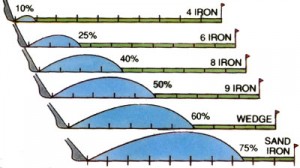Keep Scoring When the Swing Goes A.W.O.L.
Everyone goes through spells where their long game feels as though it’s packed its bags and left town for good. It can, and often does, detract from your enjoyment of the game, while a really bad bout can have you questioning your sanity and retiring those good-for-nothing sticks that are ruining your life.
How much comfort it gives, I don’t know, but there’s some solace in the fact that it happens at every level, whether it’s one of your friends or a famous pro like Harrington or Woods. An AWOL golf swing constitutes a pretty fundamental problem, but personally, I believe the reason it truly frustrates more than other issues (perhaps like dodgy bunker play or nervy putting) is that it stops us scoring almost entirely. We’re into the realms of mid-teen stableford scores and dog licence matchplay thrashings. It is so debilitating and, often, humiliating.
But this is where the pros set themselves apart and still end up cashing the cheques. How many times have you watched a top pro spray it all over the course only to see them return a 72 or 73 at the end of their “horror” day? And how do they manage to conjure a score like that? Very simply, they have a short game that repeatedly gets them out of jail.
 I don’t know about you, but I couldn’t care less how I hit it if I shot 65s week in and week out. Equally, I’d go crazy if I struck it like Rory McIlroy but shot way above handicap on a regular basis. So clearly the source of the aggravation isn’t how well we hit it, but how well we score.
I don’t know about you, but I couldn’t care less how I hit it if I shot 65s week in and week out. Equally, I’d go crazy if I struck it like Rory McIlroy but shot way above handicap on a regular basis. So clearly the source of the aggravation isn’t how well we hit it, but how well we score.
It’s a modern cliché to bang on about the importance of scoring shots from within 100 yards, so instead of simply emphasising the value of improving this area of your game, here’s a simple chipping drill that will actually give you with the tools to address any chipping problems you may have.
You’ve probably seen, read, or tried the pretty well known putting drill that requires you to hit putts from increasing distances to within a certain length in order to improve your control of pace. It’s one I’ve used on many occasions and fully advocate, but you can apply this same concept to your chipping with what I believe are even more beneficial results.
Stage 1
Find a chipping area with plenty of length to it, and start the drill by hitting a short chip-and-run shot to a target 10-12 feet in front of you. Take a second ball and play the same chip shot, but with the goal being to hit this ball slightly further than your first effort. The aim of the drill is to continue hitting chip shots beyond the previous ball. Anytime you hit a chip that finishes short of the last one, or off the end of the green, you start the drill again. Your first goal is to get as many chip shots as possible to finish between your first ball, and the end of the green. Simple! You’ll quickly notice that as your success at this game increases, your striking consistency naturally improves, as does the feel of pace, spin, and control.
Stage 2
Once you’ve got a good feel for one club, you can try it with others too, so that you learn the same control with two or three different clubs in the bag. If you can develop your control with an 8 iron, gap wedge, and lob wedge for example, then you’ll quickly establish a huge variety of short game shots around the green.
 Now play the same game but alternate clubs between shots. So instead of hitting 8 iron, 8 iron, 8 iron… with increasing levels of force, you might hit 8 iron, lob wedge, gap wedge, lob wedge, 8 iron, etc, each time attempting to hit your shot a little past the last. This way, you’ll quickly learn how to use the three different clubs to hit chip shots the same distance. You’ll soon start to notice where these various shots land, how they react when they bounce, and indeed how to play a multitude of trajectories and spin. Undoubtedly this will help you around the greens.
Now play the same game but alternate clubs between shots. So instead of hitting 8 iron, 8 iron, 8 iron… with increasing levels of force, you might hit 8 iron, lob wedge, gap wedge, lob wedge, 8 iron, etc, each time attempting to hit your shot a little past the last. This way, you’ll quickly learn how to use the three different clubs to hit chip shots the same distance. You’ll soon start to notice where these various shots land, how they react when they bounce, and indeed how to play a multitude of trajectories and spin. Undoubtedly this will help you around the greens.
The value of this on the golf course is unparalleled. Consider those awkward little lob shots over a bunker, or the bump’n’run shots along a double tiered green. Instead of blindly choosing your ‘go to club’, you’re now armed with an array of short game shots that Phil Mickelson would envy! Plus, you’ll have the confidence and visual feedback to know you can pull them off. I can’t promise that this drill alone will appease the frustrations associated with an absent golf swing, but your scores and enjoyment of the game certainly won’t continue to suffer when it does go AWOL.